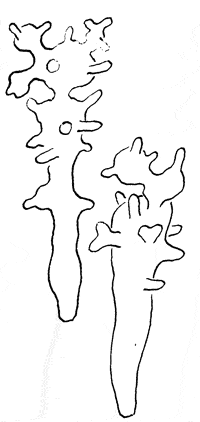Among fallen leaves of Fagus and
firmly attached to these by a dense growth of fibrils, typical in heath forests (low pH). Sometimes fruiting in hundreds and almost forming a carpet on the ground. Autumn. Rare in Norway, but locally common in a few Fagus localities in Vestfold and Agder.
Pileus 10-30
mm across, broadly campanulate to more or less convex, mostly
with a low umbo, slightly flattened or depressed centrally,
sulcate, translucent-striate, glabrous, lubricous when wet,
at very young stages greyish brown with white margin, becoming
pale grey brown, darker at the centre, sometimes stained with red-brown spots with age. Lamellae
23-29 reaching the stipe, ascending, narrowly adnate or
emarginate, sometimes decurrent with a tooth, rugulose and
dorsally intervenose with age, pale grey to brownish. Stipe
30-70 x 1-2 mm, hollow, terete, equal, curved below, cartilaginous,
breaking with a snap, pruinose, glabrescent, greyish brown
to dark brown with somewhat paler apex, attached to leaves
of Fagus with long, white fibrils. Odour
indistinctive or farinaceous, often reminiscent of radish after a while.
Basidia 22-28 x 5.5-7 µm, clavate,
4-spored, with sterigmata 4-5.5 µm long. Spores
8-10.9 x 3.5-4.9 µm, Q 1.9-2.8, Qav 2.3, narrowly pip-shaped to almost
cylindrical, smooth, amyloid. Cheilocystidia
13.5-40 x 4.5-10 µm, clavate to somewhat irregularly
shaped, covered with few, rather coarse, unevenly
spaced, simple to somewhat branched, straight or curved
or even flexuous excrescences. Pleurocystidia
not observed. Lamellar trama dextrinoid. Hyphae
of the pileipellis 2-3 µm wide, covered with simple
to much branched excrescences which tend to form dense masses. Hyphae of the
cortical layer of the stipe 2-3 µm wide, smooth to
sparsely diverticulate, terminal
cells clavate with excrescences. Clamp connections present at all tissues.
Microphoto of cheilocystidia.
The substrate - fallen leaves of Fagus
- is characteristic for this species, but other Mycena
species can be found in the same habitat and growing in
the same manner (e. g. Mycena
galopus). As Smith (1947) put it: "One would
not be likely to confuse this species with other gray or
cartilaginous Mycenae, but it does lack an outstanding character".
From my experience it can be identified on account of the
habitat, a cartilaginous stipe, which is usually conspicuously
curved below, cheilocystidia with finger-like excrescences,
narrow spores, and (mostly) a farinaceous odour. Mycena flavescens sometimes co-occurs but can be identified by the faint yellowish lamellar edge, by having more fragile fruitbodies and in having cystidia covered with warts and short excrescences.
Smooth cheilocystidia, mentioned by Smith
(1947: 300) to occur in American material, have to my knowledge
not been observed in Europe. Smith also reported M.
fagetorum growing on Quercus leaves.

Cheilocystidia
Mycena fagetorum, Aronsen M 19/85,
Teieskogen, Nøtterøy, Vestfold 6 Oct 1985
More microscopic
features
|